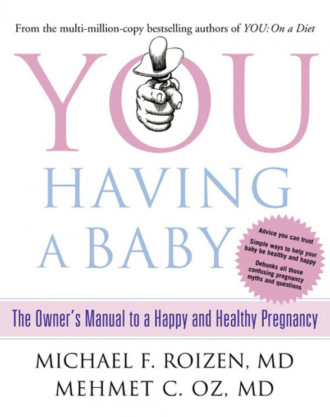
Полная версия
You: Having a Baby: The Owner’s Manual to a Happy and Healthy Pregnancy

YOU
Having a Baby
The Owner’s Manual to a Happy and Healthy Pregnancy
MICHAEL F. ROIZEN, MD
AND MEHMET C. OZ, MD
with Ted Spiker, Craig Wynett, Lisa Oz, Linda G. Kahn,
and Margaret L. McKenzie, MD
Illustrations by Gary Hallgren

DEDICATION
To mothers, who bring life into the world, and their babies, who are the future
NOTE TO READERS
This publication contains the opinions and ideas of its authors. It is intended to provide helpful and informative material on the pregnancy-related subjects addressed in the publication. It is sold with the understanding that the authors and publisher are not engaged in rendering medical, health, or any kind of personal professional services in the book. The reader should consult his or her medical, health, or other competent professional before adopting any of the suggestions in this book or drawing inferences from it.
In addition, this book sometimes recommends particular products or websites for your reference. Drs. Oz and Roizen are not affiliated in any way with such products or entities (with the exception of the RealAge website and doctoroz.com). In some instances, other coauthors or contributors may be affiliated with a referenced product or website, but recommendations were made independent of such affiliation. In all instances, bear in mind that there are many websites and reference materials other than those recommended here that may provide useful information to you.
The authors and publisher specifically disclaim all responsibility for any liability, loss, or risk, personal or otherwise, which is incurred as a consequence, directly or indirectly, of the use and application of any of the contents of this book.
CONTENTS
TITLE PAGE
DEDICATION
NOTE TO READERS
INTRODUCTION: Hey, You! Having a Baby?
Part 1: YOU-OLOGY HOW TWO BECAME YOU
1. Nice Genes A New Twist on Genetics Teaches Us How a Baby Really Develops
YOU TIPS
2. Feeding Time The Delicate Role of the Placenta in the Development of Your Child
YOU TIPS
Part 2: YOU CHANGING THE BABY
3. Eating for Who? Manage the Moments When You Feel Like Feeding on Everything—or Nothing at All
YOU TIPS
4. Growing to Extremes How to Make Sure Your Baby Isn’t Too Plump or Too Puny
YOU TIPS
5. Makes a Lot of Sense The Fascinating World of Senses Teaches Us About the Amazing Development of the Brain
YOU TIPS
YOU TOOL INFANT MASSAGE
Part 3: THE BABY CHANGING YOU
6. The Mind of Mom Manage Your Stress, Sleep Better, and Find the “Om” in Mom
YOU TIPS
7. Let’s Talk About Sex How Hormonal Changes Can Do Quite the Number on You and Your Body
YOU TIPS
YOU TOOL HOW TO PICK A BIRTHING CLASS
8. Body in Motion Tackle the Unpleasant, Uncomfortable, and Sometimes Risky Side Effects of Pregnancy
YOU TIPS
Part 4: YOU BRINGING BABY INTO THE WORLD
9. Special Delivery Find Your Way Through the Adventure That Is Labor and Birth
YOU TIPS
10. And in the Beginning … Challenges—and Rewards—of the First Month After Delivery
11. Your Pregnancy Plan Use This Checklist to Arrive at Life’s Most Amazing Destination
12. Your Pregnancy Toolbox Essential Strategies for Improving the Health of You and Your Child
YOU TOOL 1: Exercise
YOU TOOL 2: Choosing Your Care
YOU TOOL 3: Guidelines For Medications And Toxins
YOU TOOL 4: Preparing Your Home For Baby
YOU TOOL 5: Pop’S Pregnancy Recipes
YOU TOOL 6: Just For Dad
Appendix
Appendix 1: The You Prepregnancy Plan
Appendix 2: Fertility Issues
Appendix 3: Vaccinations
Appendix 4: The Basics of Preemies and Multiple Births
Appendix 5: Postpartum Depression Scale
Appendix 6: In Utero Growth Chart: Average Size
INDEX
ACKNOWLEDGMENTS
OTHER WORKS
COPYRIGHT
ABOUT THE PUBLISHER
INTRODUCTION Hey, You! Having a Baby?
Stand at the edge of the Grand Canyon, and your body rockets into sensory over-load. Your eyes widen, your jaw drops, and your neurons spit out more adjectives than a novice novelist. Majestic, awe inspiring, glorious, astonishing, so my-oh-my beautiful that you want to fall to your knees and bow to the deity that created this masterpiece.
Then you freak out.
That, in essence, is pregnancy: On one hand, it’s the most breathtaking thing you’ve ever experienced. On the other, it’s a looooong way to the bottom of the canyon, just as it is a looooong way from conception to birth—so you can’t help but have some anxiety about taking a wrong step along the way. There’s no doubt that pregnancy evokes a similar diversity of emotional and physiological responses as do such natural wonders: laughing, crying, screaming, dry mouth, dry skin, dry heaves (and that’s just the first day). What we’re here to do is help you manage both extremes of the emotional spectrum, so you can appreciate such a miraculous process and conquer the anxiety and tension through a very powerful weapon: knowledge.
Whether this is your first pregnancy or your fourth, or you’re trying so hard that you’re spending more time on your bed than a throw pillow, you probably think you know a thing or two about being pregnant. Either you’ve gone through it before or you’ve had friends, sisters, and sixteen trillion baby bloggers to give you the inside-the-womb scoop.
However, we’d ask that you hold on one diaper-changing minute. We’re here to bust myths, challenge your brain, and prepare your body for the greatest journey that any human can ever take—from the moment two cells become one to the second that your little squirt makes its first appearance outside the comforting shell of your belly.
To whet your appetite, we’d bet a case of Gerber bananas that you didn’t know things like:
• The whole notion of nature versus nurture is as wrong as a three-legged crib. That’s because a cutting-edge field called epigenetics has shown us that you have control over how the genes of your baby will express themselves.
• What happens during these 280 days on the inside actually teaches your child about how his body should act on the outside. He’s actually forecasting his future—and that teaches him how healthy or unhealthy he will be years down the road.
• While most people assume that a mom’s biological cocoon supports the child unconditionally, the truth is that your body is actually engaged in a very delicate dance to balance the often competing needs of mom and child.
• There’s a biological reason why your areolas are dark, why your feet swell, and why one minute you gag at the thought of eating a cracker and the next minute you can’t wait to get your hands on a salsa-smothered cantaloupe.
The good news is that we’re here to help by teaching you crazy-cool things about your body and giving you the tools to maximize your experience and get the result you want: a healthy and happy baby.
Now, if you’re like most women, we’re guessing that you’ve already spent a lot of time thinking about what’s in store. You’ve probably spent all-nighters scouring pregnancy websites and parked yourself in cushy bookstore chairs with thigh-high stacks of mom-to-be manuals. Maybe you haven’t been this nervous since your sixth-grade oral report on rain forests, or maybe you haven’t been this obsessed with something since McDreamy made his prime-time debut a few years back. You’re probably poring over baby names, wondering why you crave pretzels dipped in marinara sauce, and debating about whether the nursery walls should have the hue of sunshine, cotton candy, or pomegranate juice.
Nope, there’s nothing quite like this internal conflict that is pregnancy. One moment, you’re thrilled, elated, and impatient for your baby’s first smile, babble, and soothe-your-soul hug. The next, you feel anxious about a million unknowns—about what’s going on inside your belly, about whether your little one is growing properly, about how you’re going to function on zippo sleep. Since this happens to just about everyone, it must, in fact, be strangely ideal. The truth is that vigilance has great benefits. You’re supposed to pay close attention. Our goal is to ensure that you focus on the right clues.
As you struggle to maintain your equilibrium, we want you to relax and take time to enjoy the beauty of the process. The most important thing to keep in mind is that most pregnancies turn out absolutely fine. Absolutely fine. Women’s bodies are designed to carry children safely and efficiently. That doesn’t mean everything will be smooth sailing on this journey, but it does mean that the odds are greatly in your favor. If you can learn how to maximize your chances that nature runs the course it’s supposed to, you will increase those odds even further. This book will help show you how.

Introducing Your New Dance Partner
So let’s start by rethinking our perception about conception (and beyond). Back in sex-ed class, most of us were taught a pretty simple recipe for how pregnancy works:
Ingredients
1 egg, mature
100 million sperm, very, very excited
Instructions
Preheat oven. Mix ingredients romantically. Cook bun for forty weeks.
Sprinkle with love and serve to the world.
The bun-in-the-oven image has served us well over the years, underscoring the belief that mom is protector and baby is protected, that mom is cook and baby is concoction, that mom is in control and baby is not. But there’s a fundamental problem with this analogy when it comes to the true biology of pregnancy (besides the fact that nobody bakes buns anymore): Baby has a heck of a lot more say about the whole process than a cinnamon raisin roll does.
In fact, pregnancy is more like dancing than cooking. You and your baby have a dynamic, choreographed relationship—one in which you lead and the baby follows. Your subtle movements and directions help show your baby how to grow and develop. After all, it takes two to tango, or in pregnancy terms, it’s uter-us, not uter-I.
But your baby isn’t always the most cooperative partner. Sometimes he’ll want to take the lead, sometimes he’ll send you signals about which way he wants you to move, sometimes he’ll improvise, sometimes he’ll do flips, and sometimes he’ll step on your feet and get everything all tangled up. Part of the reason he’ll act this way is that your body has a certain amount of biological ambivalence about this little cellular critter; after all, only half his genes are yours. Your relationship with him isn’t exactly hostile, but it’s not always warm and fuzzy either. Even at this young age, he’s going to try to assert himself, and your body may try to resist. There are evolutionary reasons for this, which we’ll discuss in the pages to come, but you can also think of these initial rebellious acts as practice for the years ahead.
Pregnancy can be as elegant as a waltz, as high-energy as a salsa, and as scattered as a twist (with a whole lot of shouting). Our main goal in YOU: Having a Baby is to teach you about this ingenious biological dance—a dance in which you have the ability and the artistry to guide your baby not only to a healthy delivery, but to a lifetime of good health as well.

What’s in It for YOU
While many pregnancy books tell you what to do, we aim to add a deeper level of meaning in true YOU style and explain why. After all, when you truly understand the why, the what is much easier to adopt. Instead of giving you a week-by-week or hiccup-by-hiccup guide to pregnancy, we’re going to take a more holistic approach, focusing on how your mental and physical health affect your baby, and how—at the same time—pregnancy affects your mind and body. Of course, we’ll provide plenty of our signature YOU Tips and YOU Tools to help you make the best choices for a safe and healthy pregnancy, but we’re going to take you there a little bit differently than other pregnancy guides may. Here’s what you can expect* from us:
We want you to understand at the base level how epigenetics works and why it’s important. Starting with the moment you go from making love to making a baby,† we’re going to explain how you can influence your child’s development through this field—perhaps the most important developed in the last decade. Many of us believe that the genetics of our children are predetermined the moment that the sperm radar locks on its desired egg. But the truth is that research from various sources is suggesting that during pregnancy, you may actually be able to turn your future baby’s genes on and off. Epigenetics is not just how the musical notes of our genes are played but also how loud the volume is turned up. Since the acoustics in the womb and the real world might be different, we want these as aligned as possible. And that’s where all the magic takes place, no matter where you are in pregnancy or in parenthood. You have the ability to control genes anytime.
You’re also going to learn quite a bit about the key player that mediates between you and your baby, transmitting all the signals that create those epigenetic changes. That player, which gets about as much attention as a dollar bill on a blackjack table, is the placenta. This beautifully functioning organ is the place where mom and child interact, where nutrients are exchanged, and where growth and development patterns are determined.
After explaining the workings of the placenta, we’ll focus more closely on nutrition (both yours and baby’s), explaining how too much, too little, or the wrong nutrients all play roles in the health of both you and your child. Here you’ll discover why the thought of food makes you green on some days, while other days you long for an artichoke-heart milk shake. We’ll also talk about such things as fetal brain development, how to manage (and prevent) postpartum depression, and important pregnancy-related medical conditions like gestational diabetes.
In the second half of the book, we’ll help you manage the wide range of side effects you may be feeling—everything from heartburn and insomnia to medical complications like preeclampsia. Finally, we’re going to present a bunch of great features you can use, including:
Broadway to Birth: Our cool, interactive board game will take you through the amazing adventure that is labor and delivery to help you understand which elements you can control and which elements you need to leave to the pros (whom we’ll help you choose, based on your own labor and delivery goals).
A Top Eight List of Postpartum Issues: And after you deliver your baby, you’ll appreciate our chapter on everything you need to know to take care of yourself and your newborn in the first month of life. This is where the second adventure begins.
The Ultimate Pregnancy Flight Plan: Step by step, we provide the instructional dials, controls, and levers that will allow you to pilot your way to a safe landing. After all, you’re carrying a very precious passenger. This plan is the shorthand version of all the best tips and strategies we give throughout the book.
YOU Tools: At the end of the book, we will give you specific advice about exercise, diet, vitamins, and the like that should serve as an action plan not only for pregnant women, but really for all potentially fertile women (that’s because 50 percent of pregnancies are unplanned, and the actions you can take for your baby can start at least three months before sperm and egg mate). We also provide guidance on everything from choosing a doctor or midwife to preparing your home for a baby to recipes your partner can make for you during your pregnancy.
Yeah, Baby!
Before you get to most of the features at the end of the book, we think it’s helpful to really understand the way the pregnant body works—and remember, it’s your whole body that’s pregnant, not just your belly. Woven throughout the book, you’ll see several major themes that reflect our overall view of pregnancy:
• Your body is an amazingly resilient and adaptive piece of biological machinery. The size of your belly and the stretching of your skin aren’t the only changes that occur during pregnancy:Your insides are metamorphosing too. Your heart beats faster to make sure nutrients are pumped to the fetus. Your hormone levels fluctuate to prepare your uterus for growth. Your musculoskeletal system relaxes, giving you more flexible joints and more curvature in the back to prepare for carrying and delivering a baby. All these transformations mean that you may experience some unpleasant side effects (like constipation, for example). What’s interesting is that there’s an adaptive value to many of the symptoms of pregnancy, so that the nausea, breathlessness, and aching back you might feel, evolutionarily speaking, serve some value in protecting the growth of your child.
• The goal of pregnancy isn’t just to deliver a healthy baby but to lay the foundation for lifelong good health for your child—not to mention that of his children and grandchildren. That’s the amazing thing about epigenetics. Once you see some of the long-term effects you can have on the health of your child while you’re pregnant, you’ll realize that it’s important to start this process with the end goal in mind. We like to call it reverse engineering.
One of the ways that you can increase your chances for a successful pregnancy is to learn as much as you can about what’s happening, so you won’t be anxious. Simply educating yourself about what’s going on in your body is one of the smartest things you can do, because it allows you to roll with the punches rather than get KO’d by every little symptom or complication. In fact, staying calm during pregnancy has repeatedly been shown to have a positive influence on your child’s health.
So we want you to take the pressure off of yourself and not to try to do it alone. The key is to have some support, regardless of whether you’re married (about 40 percent of children are born out of wedlock), in a relationship, or flying solo. Your mother, sisters, friends, or even the internet buddies you meet on pregnancy websites can all become part of your support system. One of the features that has always distinguished human beings is that pregnant women have relied on other women in their communities to support them. Today, social support has been linked to improved fetal growth. (Those cavewomen knew what was good for them.)
In a way, managing your pregnancy really comes down to one overarching goal: managing stress. We’re not just talking about stress management in the traditional bubble-bath kind of way, but in the big-picture kind of way. How does your body cope with the stress of housing and growing what’s essentially a biological hitch-hiker? How does your baby adapt to potentially stressful situations that he’ll face in utero? (“Jalapeño attack, nine o’clock!”) How do you calm your mind in the face of the normal and natural anxieties that often arise during these nine months? How do you tell your mother-in-law that, no offense, but you prefer not to name your child Horatio Horace Humphrey?*
That’s exactly why we developed the ultimate pregnancy quality-of-life and stress quizzes. You can take them now (in this book or online at www.realage.com), as well as at various points throughout the next nine months, to see how you’re coping with all of the outside influences on your pregnancy.
Although neither of us has actually experienced pregnancy (obviously), between the two of us, we’ve fathered six children, and if you include our entire authorship team (half of whom are women, including an ob/gyn), we’ve had fifteen kids and delivered or participated in the delivery of more than eight thousand little tykes. So we have a pretty good idea of what it feels like to walk in your soon-to-be-too-tight shoes.
If you’re pregnant right now, we want to offer both congratulations and thanks. Thank you for letting us join you on this journey, and thank you for having the curiosity and passion for learning about what’s going on under the surface, under the skin, under the elastic-waistband pants you’ll soon be needing. As we step out into our exploration of this miraculous mambo, we would be impolite if we didn’t ask one final question: Would you like to dance?
Pregnancy YOU-Q: Your Quality of Life Quiz
When somebody puts the words pregnancy and test in the same sentence, you expect to read about a little stick that gives you a yes or no, pregnant or not. We’re betting this pregnancy test is like none you’ve ever taken. For one thing, it isn’t going to give you an A or an F, a pass or a fail. This test is about something bigger: about understanding yourself and all the experiences that make up pregnancy. Some are exciting, some are stressful, and some may even be a bit painful.
This test is designed to help you get a sense of how you’re experiencing your pregnancy: how you feel about yourself, your journey, and the promise of parenthood. We will give you an overall score at the end of the test that will serve as a beacon to help you navigate that journey and guide your ship to calmer waters.
Take the test as often as you like, especially as your grow and learn about yourself during these nine months. Your score may change along the way—and that’s because you will too.
YOUR Quality of Life: Sex
Answer each of the following questions on a scale of 1 to 5, 5 being this is Very True of Me:

Now check the box that best describes your feelings about this statement:

Sex Score

Interpreting Your Score






